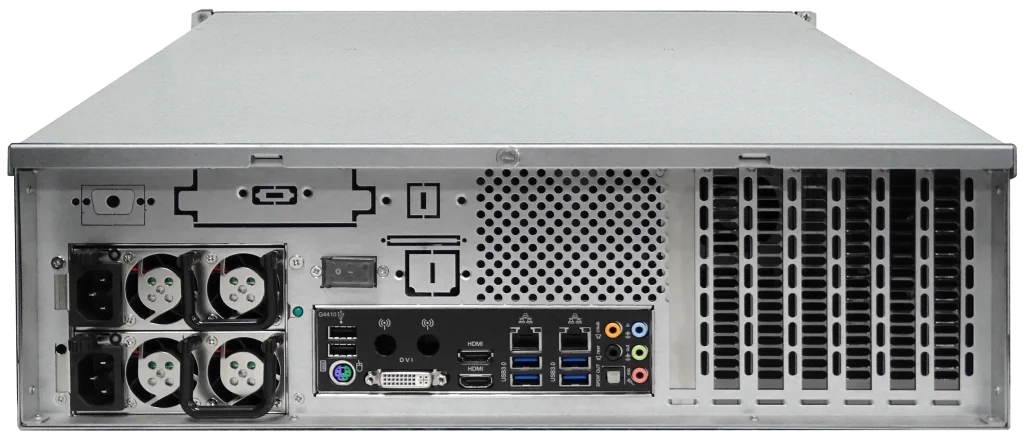Thin provisioning refers to allocating data on-demand, which means that volume consumes a small amount of storage and increases as more data is written to disk. So thin provisioning sometimes is known as just-in-time capacity or over allocation. To put it in another way, thin provisioning allocates storage space that may or may not exist. The whole idea is actually another way of virtualization. Virtualization is always about a logical pool of physical assets and provides better utilization over those assets. Here the virtualization mechanism behind thin provisioning is storage pool. The capacity of the storage pool is shared by all volumes. When write requests come in, space will be drawn dynamically from this storage pool to meet the needs. The size of a volume request is called the virtual size compared to the actual size. Therefore, the IT administrator must monitor the status of the usage and increase the physical disks at any time to prevent the actual space from being insufficient.
.webp)
Advantages of Thin Provisioning for Enterprises
·
For
IT environments that use multiple hosts and applications, thin provisioning
speeds up storage provisioning, simplifies management and reduces costs by
enhancing storage utilization.
· · Without thin provisioning, IT environments either have to deal with disruption when dedicated storage space for a LUN is consumed or they fat provision their storage infrastructure excessively. Both solutions are inefficient, costly, and exhaust resources. With thin provisioning, the available resources can be effectively leveraged and when allocated storage is consumed, more storage can be added without delay or disruption.
· · Thin provisioning can also be paired with other data services to enhance storage utilization. For instance, compression services pair nicely with thin provisioning. Thin provisioning effectively leverages the available storage space while compression reduces the overall footprint of the data.
Even though the cost
per GB is dropping, there is no need to waste space when there is a simple
solution to maximize utilization of it. Thin provisioning, also referred to as
virtual provisioning, provides this solution by allocating physical space in
smaller pieces rather than allocating and dedicating the entire volume at
provisioning time.
The volume presented
appears to be the full provisioned capacity to the application servers, but
nothing has been allocated until write operations occur. This not only delivers
3x better storage utilization but also eases system administration because
there is no penalty for presenting large volumes to the application servers on
day one.
With flat IT budgets
and the ever-increasing amount of unstructured data, as well as the high
percentage of cold data consuming expensive primary storage on NAS systems,
organizations clearly need a cost-effective way to efficiently store and manage
all this data. A strong, flexible SDS solution that facilitates the use of thin
provisioning and object storage with NAS systems will provide organizations the
budget-friendly means to meet this difficult challenge.
Enterprise storages providing thin-provisioned filesystems; they have virtual size and expand/shrink on demand as the usage reaches the fs size.
 Thin provisioning can
be likened to an empty room with a number of inflatable castles inside. The
castles each start with their initial inflation amount. As demand rises they
each independently inflate to needed levels. Each castle has an upper inflation
limit, and the castles in total cannot inflate beyond the room. In this analogy,
the castles are file systems, and the room is the available storage.
Thin provisioning can
be likened to an empty room with a number of inflatable castles inside. The
castles each start with their initial inflation amount. As demand rises they
each independently inflate to needed levels. Each castle has an upper inflation
limit, and the castles in total cannot inflate beyond the room. In this analogy,
the castles are file systems, and the room is the available storage.
In contrast, hard
provisioning is like building a city with permanent stone castles. The ultimate
size of the castle is determined upon completion of the foundation. Any
subsequent change to the size would require additional, possibly major,
construction.
Much like the portable inflatables, thinly provisioned file systems can automatically expand up to a pre-determined maximum limit. These pre-determined limits are defined at configuration of the file system in conjunction with an initial space allocation. Users exploring the file system under Windows would see the drive letter size as the initial allocation size.
As data is written to the thinly provisioned file system and exceeds its initial space allocation, the file system automatically expands without operator or user intervention. Subsequent write operations continue seamless expansion until the maximum limit is reached or until operator intercession.
In most thin-provisioned file systems, automatic expansion does not mean automatic contraction. In fact, only a few vendors automatically contract a file system as unneeded files are deleted. Most vendors’ products use the deleted file space for subsequent file writes, leaving the “expanded” file system space allocation as is and thus, not releasing space.





















































































.webp)
















